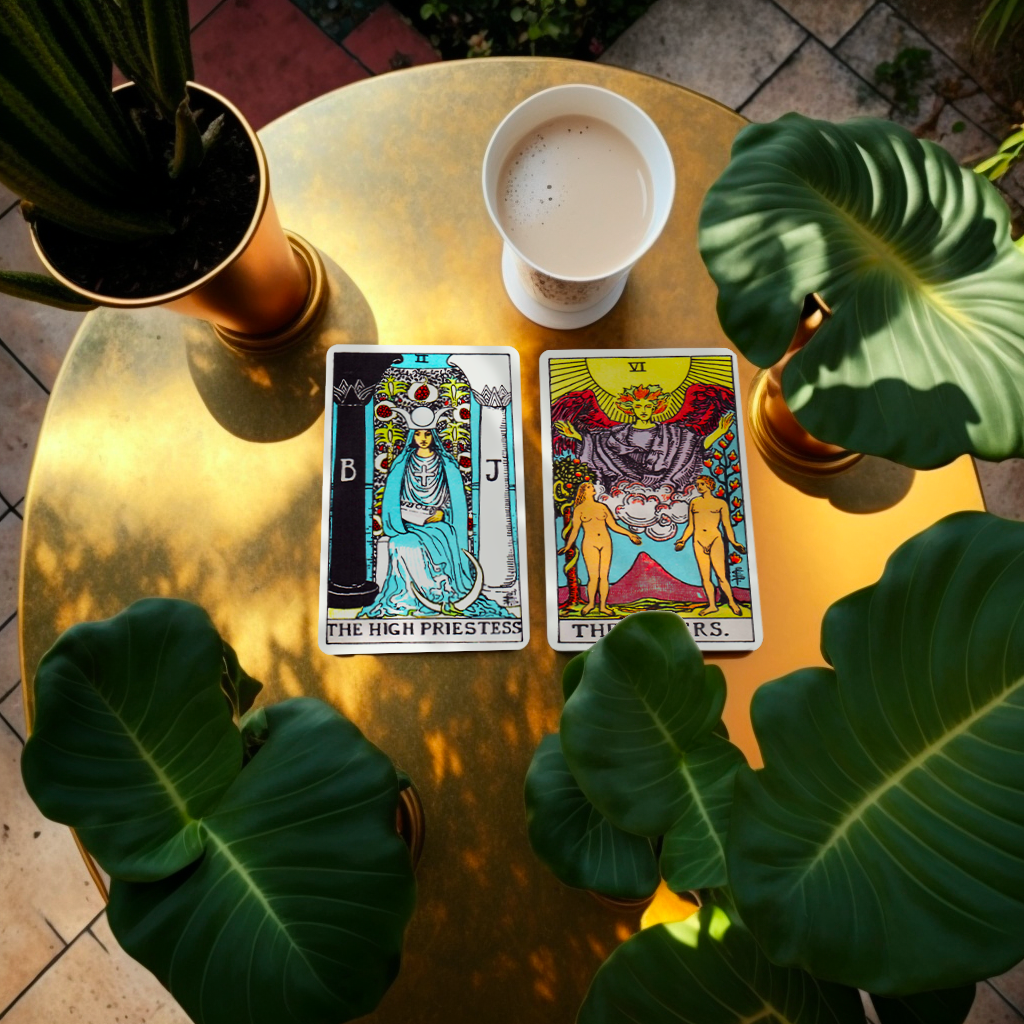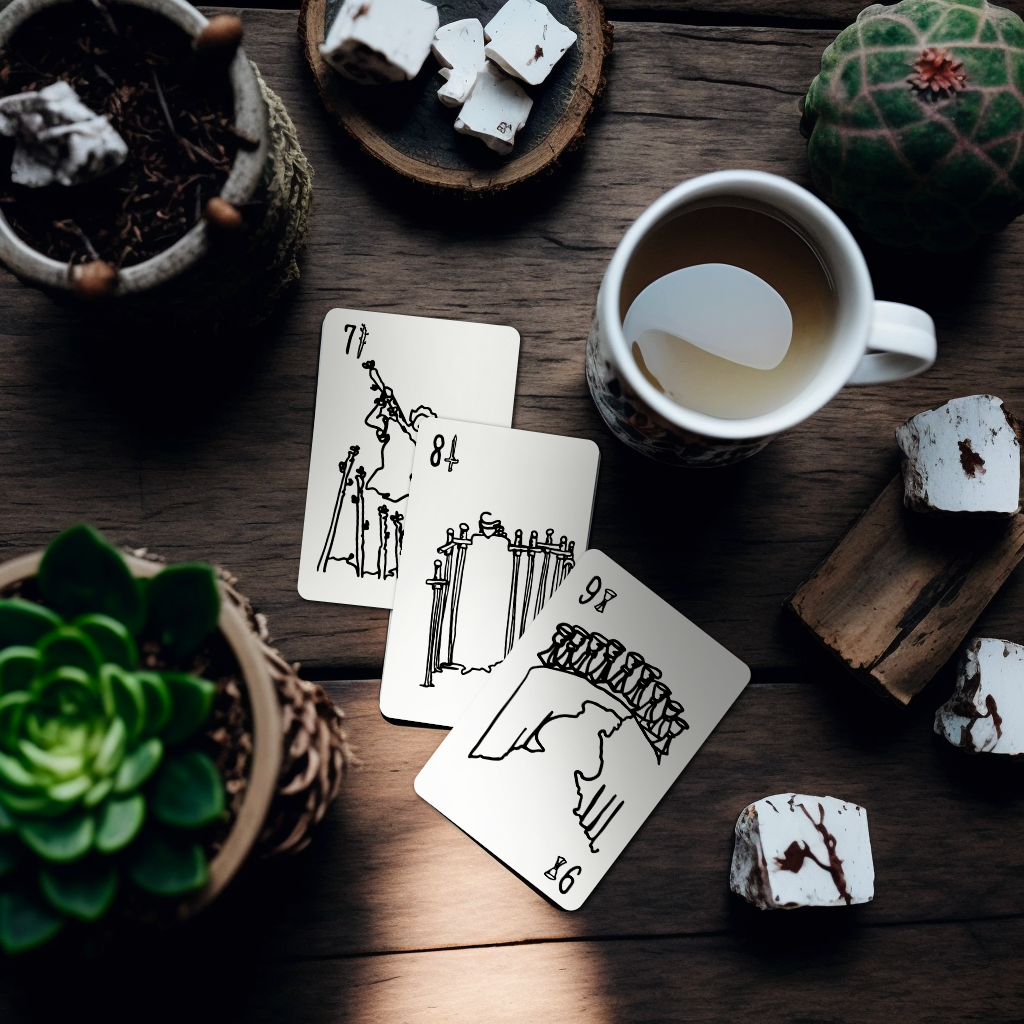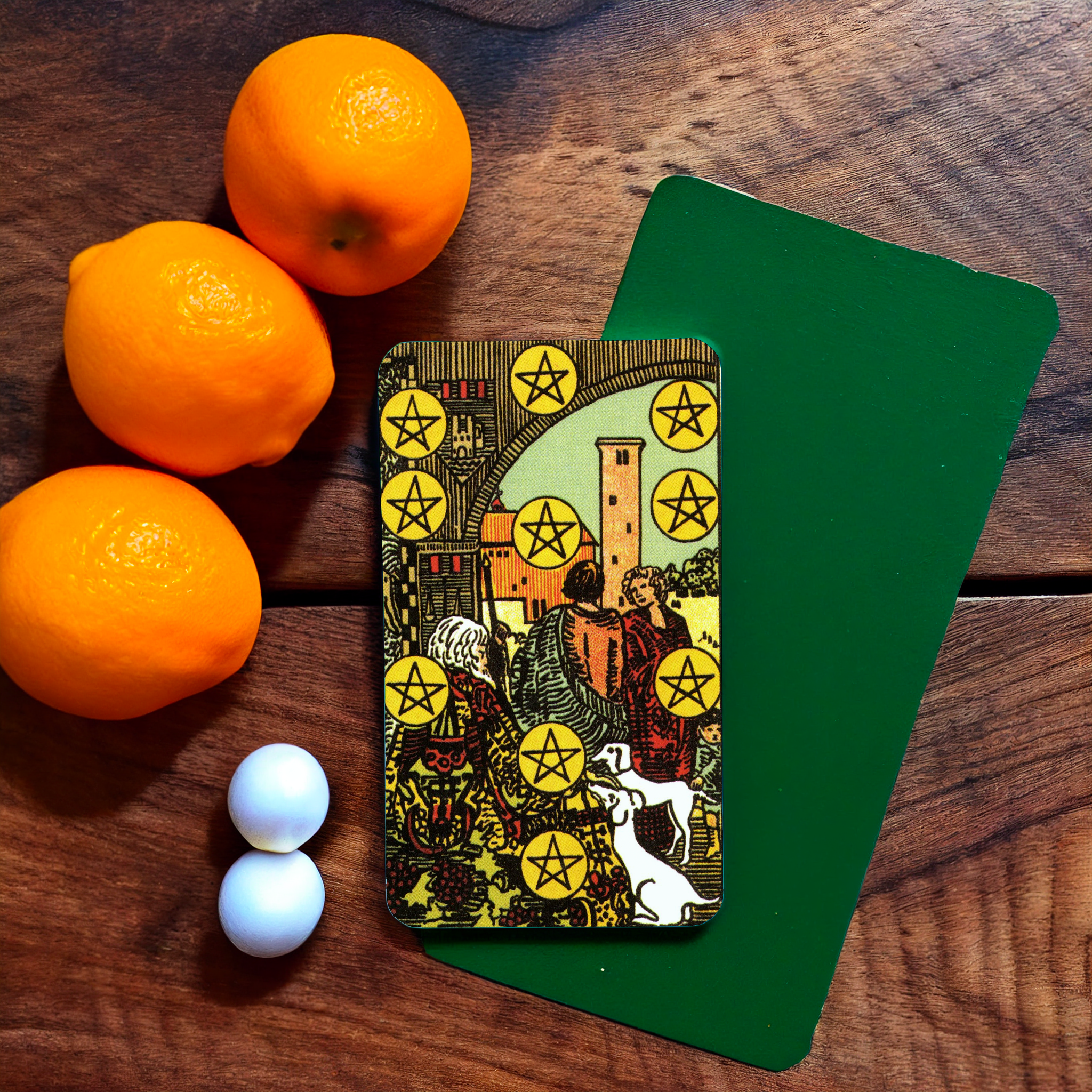Tarot Numerology: Minor Sequences
Numerology is an incredibly valuable tool for understanding the tarot.
Many of the cards in the Rider/Waite-Smith Tarot correspond to the themes of their related numbers, and many decks intentionally or unintentionally work from those card meanings.
Pamela Colman Smith’s image for the High Priestess, the major arcanum numbered 2, depicts a black and a white column, representing the duality of nature, sources of wisdom, and the space between the everyday world and psychic realm behind the Priestess’s veil of pomegranates.
The Lovers, the major arcanum numbered 6, is associated with healthy relationships and love (among other things), and the number 6 can be associated with harmony, beauty, mediation, and the productive joining of forces to create forward motion.
But even if you don’t use the popular Waite-Smith system (or can’t remember the cards’ meanings), numerology can help you create meaningful patterns.
The number 4 tends to be associated with structure and stability, even a little comfort and domesticity. As a result, it’s no surprise that the 4s of the tarot’s minor arcana tend to be stabilizing or restful cards, albeit sometimes stagnant as well.
The number 10 is a transitional number. It is both the end of the minor arcana cycle (Ace–10) and a 1 in Pythagorean numerology (where you reduce numbers to a single digit by continually summing digits), thus preparing for a new cycle. The minor arcana numbered 10 can all be seen as representations of the end of one thing and the start of another, such as the hand-off between generations.
Learning these individual numerological associations is a great way to add a layer of meaning to each of the cards. And it’s convenient to have in your back pocket in case you ever forget a card’s meaning and aren’t getting anything out of the imagery.
But what about cards in sequence?
I recently shared my attempts at using the sequential septenary system to interpret the major arcana in new ways with mixed results. And I certainly understand the value of the Fool’s Journey through the major arcana as a powerful spiritual concept.
But sequence is probably even more important for the minor arcana, where the numbers are basis for a card’s depiction and even its title.
During the final month of my Tarot to Transform Your Life small-group coaching program, we look at how the minor arcana and their sequence offer wisdom for getting things done. After all, the minor arcana are home to practical tasks, the specific work that must be done to achieve your goals once your mind, heart, and soul are in alignment.
Through a series of targeted tarot spreads, we look at the lessons of initiation offered by the Aces, the 2s, and the 3s; the advice for maintaining in the 4s, 5s, and 6s; the way to completion in the 7s, 8s, and 9s; and the pivotal moments of celebration and transition in the 10s.
While the specific tarot spreads are for participants in that program, I wanted to share how you can use these clusters of the minor arcana to understand some core themes that cross all four suits. This allows for the sequential development of the minors, and you can use that in your own reflective self-coaching or just in helping you get to know the minor arcana a little better so that your tarot readings are more fluent and nuanced.
Initiation
The Aces, 2s, and 3s demonstrate the initiation of the suit, from the promise of potential to actually bringing the suit to life internally and birthing it into the external world.
The Aces are cards of promise and the potential of something. They are the very start of what their element and suit represent. The opportunities that they promise may be gifts from the gods, but they can do nothing on their own. For example, the Ace of Pentacles is the seed that must be planted and nourished. It is, in itself, dormant, but it has the potential to become a great harvest if you care for it.
The 2s are dual-minded cards of connection, balance, and distinction. If you have acted upon the potential of the Ace, you must decide what to do with its potential and what not to do with it. You are working with that energy as an external other. For example, the 2 of Cups is the most promising card in a love reading because there is emotional connection between equals who have chosen each other, unlike the Lovers, where temptation lurks in the background and decisions must still be made.
The 3s are where what has been fostered from the Aces and decided upon in the 2s find its way into the external world. The potential has been nurtured and allowed to find roots, and now it gets to grow and expand as it faces the opportunities and challenges of the external world. In many cases, this is good, but it creates vulnerability. For example, the 3 of Wands is a card of activity and passion brought out from the realm of contemplated actions. Such freedom of energy allows inspiration and activity to grow via exchange: the fire is giving the space it needs to breathe.
Maintenance
Once things have been birthed, nurtured, and brought into the outer world, it’s time to help maintain the suit’s energy, giving it a container in which to grow, letting it take various experimental shapes, and finally getting into healthy motion.
The 4s step in to create a solid container from which things can grow. That requires a sturdy foundation and protection, as well as possible recovery from that initial encounter with the big bad world. For example, the 4 of Swords provides a mental resting point after the painful 3, and it is a necessary healing energy in order to continue the Swords’ striving movement. But that rest can feel like stagnation, especially when the recovery is slow or the comfort is hard to leave.
The 5s, with all of their chaos and unfocused experimentation, create an opportunity for growth out of the safe container created by the 4. In order to move, a new point of contention or conflict must be introduced. Something must agitate that stable barrier of comfort if the energy is to continue growing. For example, the 5 of Cups is unpleasant, but that discomfort creates an opportunity for reconnecting to emotion after the numbed 4. The 5 re-energizes its suit and gets it out of that stable, predictable, and stalled pattern that is no longer needed after the foundation is laid and wounds have sufficiently healed.
The 6s are the cards of harmony and mediation, of beautiful progress and natural flow. After the storm comes the rainbow. After the stormy 5s, enough energy has been generated that the coast is clear to move ahead productively as the 6 mediates between the balance of 2 and the expansion of 3. Because of this, 6s go with the flow of energy and ensure that things keep moving. For example, the 6 of Pentacles shows the flow of material goods in the giving and taking, demonstrating the current of currency. Things, including bodies and money, create new things when in motion. Without movement, they become stagnant again.
Completion
After development and maintenance, the suit is ready to come to its final stage before transitioning into a new cycle. The work on steady maintaining creates the opportunity to demonstrate experience, push past limitations, and arrive at the necessary end point.
The 7s are cards of experience and leadership, where choices must be made about where to focus and how to get to the end goal on your own terms. After the easy motion of the 6s, which may have involved others’ help, the 7s show where independent efforts are needed. For example, in the 7 of Wands, there’s certainty of activity and effort that is inspiring but also contentious as those who have different goals fight against the independent actor. It is the leader’s responsibility to make a final decision or a final stand and start to bring things to a close.
The 8s describe striving and ambition, of being ready to reach the endpoint but not quite being there. Despite the stable formation of the 8s, there must ultimately be forward motion, a path toward the end state. It may be a matter of finalizing details or admitting what must be left behind in order to arrive at the end state, but it’s within reach. For example, in the 8 of Swords, it is easy to become paralyzed by all last-minute doubts and hesitations, or to lose sight of initial intentions by the all the new ideas and distractions vying for your attention. With the 8, the experience claimed by the 7 is really put to the test.
As the highest single-digit number, the 9s are the signal for culmination, where the end arrives, for good or bad. The ultimate form of the suit arrives with the 9, where dreams or nightmares may be realized. For example, the 9 of Cups is often seen as the card of absolute happiness and wish fulfillment, where all of the emotions have culminated into the joys of the suit. How such energy fulfillment appears will vary by circumstance, but there is a finality to the 9s that punctuate the suit, even though the 10 follows.
Transition
The final card of the numbered minor arcana in each suit shows what happens after the dust settles.
The 10s are the epilogue of the suit, which makes way for what comes next. It is the passing on of the suit’s energy from one state to another. It might be a transition between people or between discrete stages of a project that needs some reflection or reorientation or recommitment before continuing on. But the 10s are an opportunity to reflect, celebrate, and transfer the energy of the suit to start a new cycle off again. For example, the 10 of Pentacles shows the reflection and celebration that comes in passing on various aspects of the material world, from physical body to physical property. This point between ending and new beginning is not always joyful, but celebration and reflection are necessary whether you have achieved your dreams or your project needs a thorough post-mortem before you start the next cycle.
And if you need reflection or guidance on achieving your goals, book a reading to see what’s getting in your way and where you can focus next. Or sign up for longer-term coaching, either in the small-group setting of Tarot to Transform Your Life or through my in-depth private 1:1 coaching sessions that help unblock you for greater energetic flow, Clearing the Cascades.
Other Sequences
Earlier in this entry, I mentioned my recent blog post on using the sequence of the Septenaries to find subtle patterns in the major arcana. But I encourage you to consider the sequence inherent in the court cards. What does it mean to have a Page, a Knight, a Queen, and a King? Or a Princess, a Prince, a Queen, and a Knight? What about a Valet (not a Page), a Knight, a Queen, and a King? Or a Daughter, a Son, a Mother, and a Father? Or something else entirely?
I love seeing what new meaning is made by sequence when you look at different decks’ interpretations of court card titles. That’s a topic that I cover in my course Awaken the Court Cards and in the workbook I created to support independent exploration of the 16 personas that live in the court cards and in ourselves. It’s rich for nuanced distinctions and layering card meanings into the minor arcana.
Did you learn something?
If so, you may love my intensive fundamentals course for new and experienced tarot readers, Read Tarot like a Nerd. A new 5-week live session of the course is starting up January 18, and the self-paced version is available all year-round.







